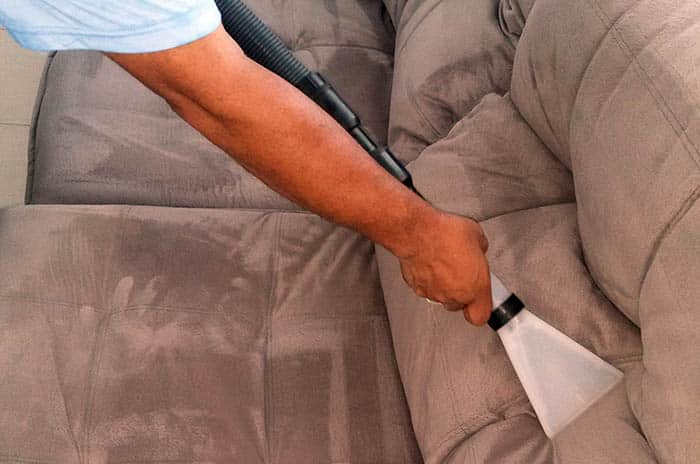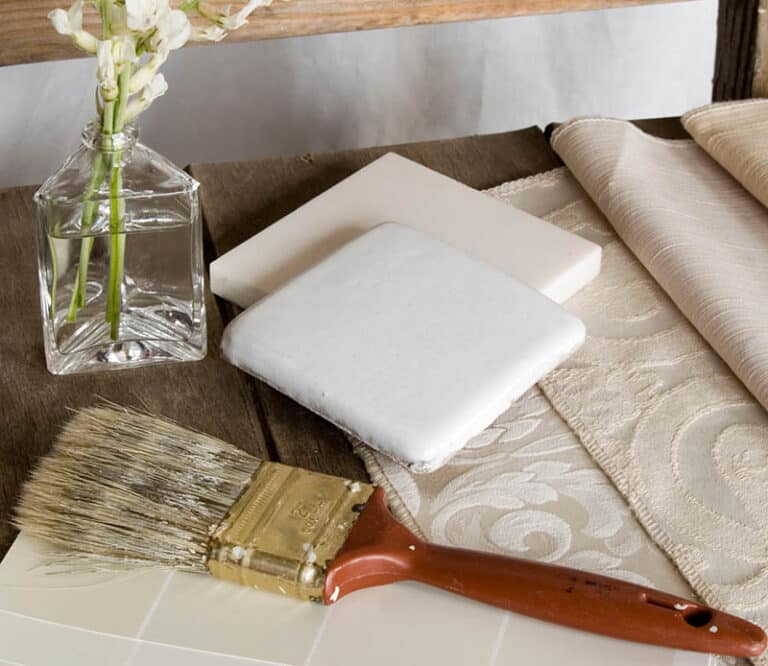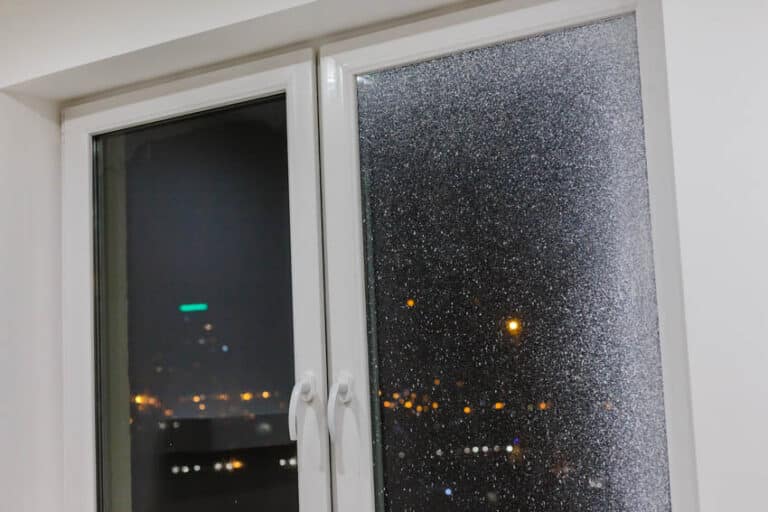How To Clean a Fabric Sofa (Removing Stain Tips)
You spend much time and energy choosing the right sofa for your home. So, it’s important to take steps to keep it looking tip-top. Always check the manufacturer’s recommendations before using any products to clean your sofa. Care guides and instructions are usually found on the sofa’s tags and will indicate if it is safe to use cleaning detergents and solutions on your sofa. This is significant because failing to use the right cleaning products may damage your sofa upholstery permanently.
Check the cleaning codes for your fabric sofa. The letters found on a sofa’s tags are not just random. They are codes that will help you with the proper care and maintenance of your sofa. [toc]
Cleaning Fabric on a Sofa
Materials:
- Water
- Spray bottle
- Cleaning agent (will depend on the type of stain you are trying to remove – see descriptions below)
Tools:
- Vacuum
- Dry stiff brush
- Pieces of clean cloth
- Rubber gloves
1. Clean the sofa with a dry brush. Go over the sofa with a dry, stiff brush that has natural bristles to remove any loose particles, dust and dirt on its surface. This will also help loosen any stain and will make it easier to remove later on.
If dealing with pet hair, wear a pair of rubber gloves and run them over your furniture. This process will create static and all the hair will stick together and you can easily vacuum it off later on.
2. Vacuum your sofa. Use a handheld vacuum to remove the loose particles that you have brushed on the surface. This will also clean any crumbs that you may have missed while brushing. Vacuuming is very beneficial before removing a stain because it reduces the risk of spreading the stain and will make it easier for spot cleaning.
Vacuuming is also good for regular maintenance of your sofa. Most vacuums come with an upholstery attachment or a stiff bristle brush which is intended for this purpose. Crevice tools are also very useful for cleaning hard-to-reach areas.
3. Treat stains quickly using the appropriate cleaning solution. Do not wait too long before treating a stain — the longer you leave it, the harder it is to clean as it has the tendency to set on the sofa material. As soon as a spill or stain occurs, clean it immediately. If the stain is fresh, you may still be able to remove it by simply blotting it with a microfiber cloth.
Several cleaning solutions are available in the market, but you can also prepare your own homemade solution as it will save you more money.
Ways to treat stains in sofa fabrics
General Cleaning of a Couch
○ General stain removal using carbonated water or club soda: Use club soda and dab it gently with a clean, white cloth (colored cloths may bleed). Another alternative is vinegar — use a little amount of vinegar and let it sit for about 15 minutes, then blot it with water. You can also use soap with water. Club soda works best for removing blood and wine stains.
○ General stain removal using “baking soda paste” : Mix ⅛ cup of water with ¼ cup of baking soda to create a thick paste. This solution can be used to clean stains like coffee and wine. Using a clean damp cloth, blot the spillage until all the excess liquid comes off then using another piece of soft cloth, apply the paste on the soiled area. Leave the paste to sit on the sofa fabric overnight. Once dry, use a vacuum to remove the paste.
○ General stain removal using white vinegar: White vinegar is effective in removing odor and stains on sofa fabrics. To create a white vinegar solution, mix equal parts of white vinegar and cool water — about a cup of each is enough if you are going to put it in a spray bottle.
Before spraying the vinegar solution to your sofa upholstery, make sure to remove any loose particles from fresh soiling. If dealing with a fresh stain, use a kitchen towel to dab on the excess fluid.
Never wipe the stain because it will just spread. Once done, commence with spot cleaning by spraying the vinegar solution on the affected area. Just remember to not over wet the stain when yous pray the vinegar solution.
Using a clean cloth, blot the stain starting from the outer edge moving towards the center. If needed, you can spray the vinegar solution again and continue blotting the stained or soiled area. Repeat this step until stain is removed.
Then rinse the area using a damp cloth.Blot until all vinegar solution is removed. Lastly, dry the are using a hair dryer. Dry the area immediately to prevent any water marks from forming.
Coffee stains
Mix equal parts of water and vinegar with a small amount of dish detergent. Damp on the stain using a clean white cloth.
Red wine stains
Sprinkle a little amount of salt on the stain, let it sit then blot it with lemon juice. Rinse with water. You can also substitute lemon juice with hydrogen peroxide. Another method to remove red wine stains from a sofa is to saturate the affected area with baking soda and then coat that with vinegar. (The mixture will bubble while you are waiting)
After a couple of minutes of soaking in you can wipe the residue away with a damp cloth. You can repeat as desired until the stain is completely gone.
Oil stains and grease
Sprinkle a little amount of salt on the stain, let it sit then dab it with a water and soap solution. You can also use rubbing alcohol instead of salt.
Blood stains
Blood stains can be easily removed with hydrogen peroxide. Just blot it with the said chemical then dab with water.
Crayon stains
Dab a small amount of white toothpaste on the crayon stain then rinse it with water. Remember that this is only effective with non gel toothpastes.
When treating a stain, never scrub your sofa. Even if you are dealing with tough stains, it is not recommended to scrub the fabric because the stain will just get further into the fibers.
Excessive scrubbing will also ruin the texture of your sofa. Just let the stain remover do its thing and then you can gently blot it with a soft cloth afterwards.
Spot treat with the recommended cleaning agent. After removing the stain, you can now begin cleaning your sofa with the recommended cleaning agent (whether water based or solvent solution) based on the codes and instructions on its tag. Follow the instructions
As mentioned earlier, you can test it first within a small area before proceeding to make sure that it won’t damage and discolor your sofa fabric. Most of this cleaning agents will require wiping with a soft damp cloth after application. Residual cleaning solution may be removed by gently brushing.
Dry your sofa. Once you have finished cleaning and rinsing your sofa, begin drying by patting down wet areas with a dry towel. This will remove any residual moisture on the fabric.
Leave your sofa to air dry. Leave your sofa to dry overnight.
How to Remove Slime from Fabric
There are two effective ways to remove slime from a fabric sofa and both require very little effort , while using only simple everyday items in your home. One is to use distilled white vinegar , and the other way is to use some rubbing alcohol. Below are the complete steps in removing slime from a fabric sofa :
Using rubbing alcohol
You’ll need:
- rubbing alcohol
- clean cloth or paper towels
- a spoon or butter knife
What to do:
1. Remove as much as slime as you can using a spoon or butter knife. Do this gently to prevent the upholstery of your sofa from getting damaged.
2. Apply rubbing alcohol to the stain using a spoon. The quantity of rubbing alcohol will depend on the size of the stain.
3. Gently scrape the top of the fabric using the spoon to loosen the wet stain.
4. Gently dab the stain using a damp cloth or paper towel to remove any excess slime and moisture.
5. Repeat the process until all the stain comes off.
6. Leave your sofa to air dry.
Using Vinegar and Baking Soda
You’ll need:
white vinegar
baking soda
bowl of hot water
dishwashing detergent
clean cloth
kitchen towel or paper towel
a spoon or butter knife
brush
What to do:
1. Remove as much as slime as you can using a spoon or butter knife. Do this gently to prevent the upholstery of your sofa from getting damaged.
2. Pour white vinegar on the slime stain. Make sure that you completely saturate the area and allow it to soak for at least 10 to 15 minutes.
3. Gently scrub the stained area using a brush
4. Sprinkle some baking soda over the stained area and add a bit of white vinegar on it. The solution will begin to produce bubbles and become a bit foamy. This chemical reaction loosens any remaining slime on the sofa fabric. This is best done as soon as the slime stains your sofa because it’s much easier to remove — the older the stain, the more baking soda and vinegar it will require and the harder it is to remove.
5. Leave it to soak for another 10 to 15 minutes.
6. Mix a bit of warm water with mild dish-washing detergent and pour it over the stain.
7. Pour a tablespoon of hot water over the stain and gently scrub the area using a brush. Add more water and scrub. Repeat this process until all the slime stain comes off.
8. Using a clean kitchen towel or cloth, dab the area to remove any excess liquid. Do not rub, just gently press the area until almost dry.
9. Leave your sofa to air dry.
How To Clean Fabric Naturally
If you do not have any cleaning agents available at home, you can always create your very own sofa cleaner using everyday pantry items. Homemade cleaners are not only cheaper, but they are very eco friendly too.
DIY Natural Cleaning Products
Here are some do it yourself cleaning solutions you can use in cleaning your fabric sofa naturally.
● Fabric upholstery : Mix 3/4 warm water with 1/4 cup vinegar and 1 tablespoon of dish detergent. You can out the solution in a spray bottle for easy use. Spritz some of the mixture on the soiled part of your sofa and gently scrub with a soft piece of cloth. Once the stain is removed, use another piece of damp cloth to remove any soap residue. Using a towel, pat to remove any remaining moisture and leave to air dry.
● Leather upholstery : Mix ¼ cup vinegar with 1/2 cup olive oil and put the solution in a spray bottle. Spritz over the surface of your leather sofa and wipe with a soft cloth.
● Synthetic upholstery : Mix 1 cup of warm water with ½ cup of vinegar and 1/2 tablespoon of mild dish detergent in a spray bottle. Spritz some of the mixture on the soiled part of your sofa and gently scrub with a soft piece of cloth until the stain lifts.
● Baking soda solution for general cleaning : Sprinkle entire couch with baking soda to remove any odor and loosen stains. For deep set stains, make a “baking soda solution” by mixing equal parts of water and baking soda and apply on the sofa surface.
Whether you are using the wet or dry solution, you have to let the baking soda sit for about 15 to 20 minutes for it to be absorbed by the sofa upholstery. Once it sets, use a vacuum with brush attachment and gently go over your sofa. Make sure to vacuum all parts and remove any excess baking soda. There is no need to rinse the solution, just leave it to air dry.
Other Sofa Cleaning Hacks
Baby wipes : For quick DIY upholstery cleaning, use baby wipes. Baby wipes are incredibly effective and gentle to use on any type of fabric because they have very little moisture and has just the right amount of soap.
You can also use baby wipes to quickly clean liquid spills, coffee drips and other dirt. Just wipe it on the stain immediately before it even has the time to set n your sofa’s upholstery. Remember to make sure to check your manufacturer’s instruction before cleaning your sofa with wipes as some may be harmful to certain types of sofa fabrics.
List of Sofa Cleaning Codes and What They Mean
● X: Use a vacuum only. Fabrics with this code can only be cleaned by light brushing and vacuuming. It is not cleanable with water, solvent cleaners and other products.
● W: Stands for “Water based cleaner”. Fabrics with this code are easiest to clean because they can be cleaned with water, water based shampoo or foam cleaner. However, this is different from being “machine washable”. You can use a brush for spot cleaning your sofa upholstery.
● S: Means “solvents” and dry clean only. Sofa fabrics with this labels must be treated with water free solvents and dry cleaning detergent only. When cleaning sofas with solvent cleaners, make sure to do it in a well ventilated room.
● WS: A W/S code means you can use a combination of dry cleaning solvents and water based cleaners. You can either use a mild detergent, dry-cleaning detergent, upholstery shampoo. Although there are many options you can use, make sure to pretest the product first just to make sure that it is safe to use. These fabrics can be spot cleaned with a steam vacuum.
Pretest a cleaner before proceeding. Before putting that cleaning product all over your sofa, it is always a good idea to pretest it first on a small, inconspicuous spot. This is just to make sure that the cleaner will not cause your sofa fabric to bleed and it won’t leave a spot on the sofa upholstery.
Use a microfiber cloth in cleaning your fabric sofa. The best material to use in cleaning a sofa is a soft, microfiber cloth because it won’t ruin the fabric texture. Soft brushes can also be used to loosen stains. Avoid using coarse fabrics.
For sofa styles with slipcovers, wash according to its label instructions. Most sofa fabric slipcovers require a gentle wash on cold setting. For throw pillow covers that come with your sofa, make sure them wash them inside out.










For removing stains from spilled red wine I find that liquid dishwashing detergent with cold water does the trick. I first get a cloth to soak up as much of the wine as possible before using the soap to scrub out the stain.